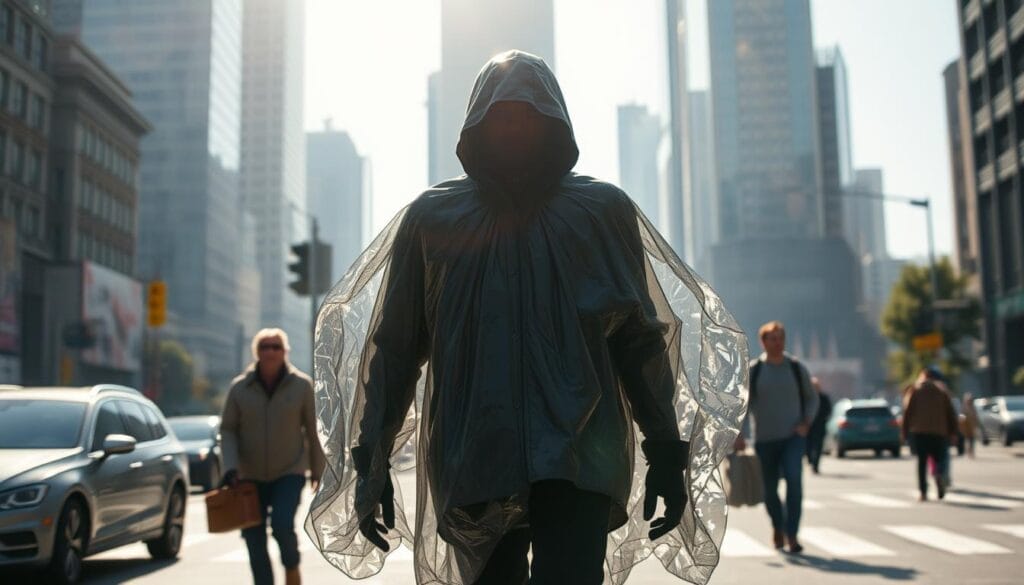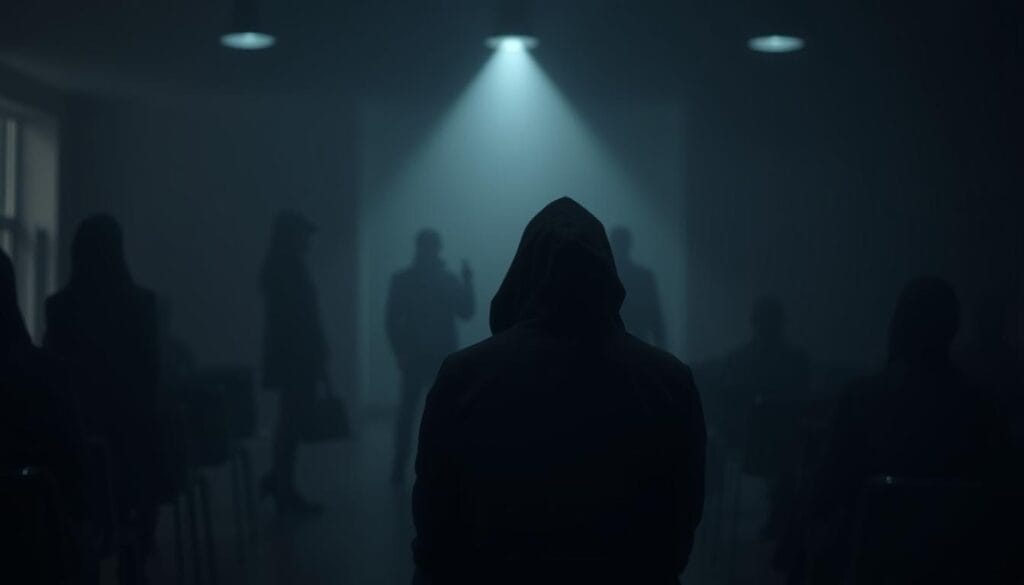Did you know that over 50% of individuals over 50 feel overlooked in social situations? This desire to blend in isn’t just about age—it’s a universal human experience. From ancient myths to modern science, the concept of invisibility has fascinated us for centuries. Whether it’s through magic tricks or cutting-edge technology, the idea of disappearing has always captured our imagination.
In this article, we’ll explore the intriguing world of invisibility. We’ll delve into historical attempts, like medieval cloaks and H.G. Wells’ The Invisible Man, and modern scientific breakthroughs such as Susumu Tachi’s Reflection Cloak. You’ll also discover practical techniques to stay unnoticed in crowded spaces, blending psychology and urban survival skills.
In today’s world, personal security matters more than ever. Learning how to be invisible in public can enable you to navigate public spaces with confidence. This guide will walk you through the principles and strategies to help you stay under the radar effectively.
Key Takeaways
- Invisibility has been a fascination throughout history, from myths to modern science.
- Historical methods, like cloaks, laid the groundwork for today’s scientific advancements.
- Modern technologies, such as the Reflection Cloak, are making invisibility a reality.
- Blending into crowds involves both psychological and practical techniques.
- Personal security is increasingly important in urban environments.
Exploring the Science and History of Invisibility
The quest to vanish has shaped both myth and technology over the years. From ancient tales of magical cloaks to cutting-edge scientific experiments, the concept of invisibility has evolved dramatically. Let’s take a closer look at this fascinating journey.
The Evolution from Myth to Modern Technology
Invisibility wasn’t always a scientific pursuit. Ancient myths often depicted it as a trick of the gods or a magical ability. For example, medieval texts describe concoctions like owl’s eye and beetle dung as a method to disappear. While these recipes seem dubious today, they highlight humanity’s early fascination with the idea.
Fast forward to the 19th century, and H.G. Wells’ The Invisible Man introduced a more scientific approach. Wells’ protagonist used index matching, a principle still studied today. This marked a shift from magical thinking to fact-based exploration.
Magical Traditions versus Scientific Innovation
Magical traditions often relied on rituals and symbols, while modern science focuses on replicating invisibility through technology. Take the retro-reflectum cloak, for example. This kind of device uses advanced optics to bend light, creating the illusion of transparency.
In the year 2006, scientists like John Pendry and Ulf Leonhardt published groundbreaking papers on invisibility cloaks. Their work laid the foundation for today’s experiments, blending physics and engineering to achieve what was once considered impossible.
Whether through ancient spells or modern devices, the appeal of invisibility remains the same. It’s a blend of curiosity, creativity, and the desire to achieve something extraordinary.
How to be invisible in public: Techniques and Tips
Modern technology offers fascinating ways to stay unnoticed in public spaces. From advanced cloaking devices to simple urban strategies, blending into the crowd is both an art and a science. Let’s explore some practical methods and cutting-edge innovations that can help you achieve this.
Implementing Reflection and Projection Cloaks
Reflection cloaks, like the one developed by Susumu Tachi, use advanced optics to bend light around an object. This creates the illusion of transparency. Positional awareness is key here—the cloak works best when viewed face-on. A step-by-step approach can help you understand its mechanics:
- Align the cloak’s reflective surface with your surroundings.
- Ensure proper lighting to enhance the effect.
- Practice moving naturally to avoid drawing attention.

Projection cloaks, on the other hand, use cameras and screens to display the background behind you. GDS Architects’ skyscraper example demonstrates this technique on a larger scale. According to expert John Smith, “These devices are a blend of art and science, making invisibility achievable in real-world scenarios.”
Everyday Methods for Personal Security
While cloaks are impressive, everyday strategies can also help you stay under the radar. Here are some practical tips:
- Dress in neutral colours to blend into your environment.
- Avoid sudden movements or loud conversations.
- Stay aware of your surroundings and maintain a low profile.
These steps might seem simple, but they’re effective in crowded urban settings. Remember, the goal isn’t to disappear entirely but to become less noticeable.
Whether you’re experimenting with a cloak or adopting urban survival skills, everything you do contributes to your ability to stay unseen. It’s a fascinating journey that combines creativity, technology, and practicality.
The Role of Metamaterials and Transformation Optics
The world of invisibility took a leap forward with the discovery of metamaterials. These new materials, engineered to manipulate light in ways natural substances cannot, have transformed the idea of cloaking from fantasy to science. At the heart of this revolution lies transformation optics, a breakthrough concept that bends light around objects, rendering them invisible to the eye.

Understanding Meta-Atoms and Refractive Index Matching
Metamaterials are made up of tiny structures called meta-atoms. These are designed to interact with electromagnetic waves in unique ways. One key principle is refractive index matching. When the refractive index of an object matches its surroundings, light passes around it seamlessly, making it appear invisible.
For example, the microwave invisibility shield developed by David Smith and his team in 2006 demonstrated this principle. By bending microwaves around a small cylinder, they achieved a cloaking effect. This was a scientist’s dream come true—a tangible step towards real invisibility.
Scientific Challenges and Practical Applications
While metamaterials show promise, challenges remain. Most experiments have been limited to microwaves, as visible light has much shorter wavelengths. Creating materials that can manipulate visible light requires precision at the nanoscale, which is still a work in progress.
Despite these hurdles, the potential applications are vast. From improving imaging systems to developing advanced optical devices, metamaterials could reshape technology. As the author of this piece, I find it fascinating how these advancements blend technological wonder with everyday practicality.
In the future, we might see metamaterials used in defence, making vehicles invisible to radar, or in medicine, enhancing imaging techniques. The world of invisibility is no longer confined to fiction—it’s a tangible, exciting frontier in science.
Illusion Optics and Wave Cloaks: Beyond the Visible
From hiding objects to bending time, illusion optics is revolutionising the science of invisibility. This fascinating field goes beyond traditional cloaking, offering new ways to manipulate perception and create alternate realities. Let’s dive into the innovations that are reshaping our understanding of concealment.

Designing Alternate Realities with Illusion Optics
Illusion optics takes invisibility to a whole new level. Instead of just hiding objects, it can create the illusion of an entirely different reality. Take the spacetime cloak, for example. This groundbreaking device doesn’t just bend light—it manipulates time itself, allowing events to be “hidden” from view.
Imagine a scenario where an event occurs, but thanks to the spacetime cloak, it appears as if nothing happened. This is achieved by precisely controlling the flow of light around an object, effectively erasing it from the observer’s perception. It’s a bit like editing a video, but in real-time.
Applications in Acoustic and Seismic Concealment
Wave cloaks aren’t limited to light—they can also manipulate sound and seismic waves. Acoustic cloaking, for instance, uses metamaterials to bend sound waves around an object, making it undetectable to the ear. This has potential applications in everything from military stealth technology to noise reduction in urban environments.
Seismic cloaking is another exciting area of research. By redirecting seismic waves, scientists aim to protect buildings and infrastructure from earthquakes. These advancements show how illusion optics is paving the path for practical, life-saving technologies.
Even a small bit of progress in this field can unlock new possibilities. From hiding objects to protecting cities, illusion optics is transforming the way we think about visibility and concealment. As we continue to explore this frontier, we owe a thanks to the pioneering researchers who are pushing the boundaries of what we once considered mere magic.
The Intersection of Technology and Personal Presence
Technology is reshaping the way we interact with our surroundings, blending invisibility into urban life. From skyscrapers that disappear into the skyline to transparent interiors that redefine privacy, the line between presence and concealment is becoming increasingly blurred. This integration of high-tech solutions isn’t just about aesthetics—it’s about enhancing security and redefining how we navigate public spaces.
Integrating High-Tech Invisibility into Urban Life
Modern cities are embracing advanced optics and computer technology to create environments that prioritise both visibility and privacy. Take the wall of a building, for example. With the right design, it can reflect its surroundings, making the structure seem almost invisible. This isn’t just a futuristic concept—it’s already happening in places like South Korea’s Tower Infinity.
This skyscraper uses a combination of cameras and LED screens to project the sky behind it, effectively blending into the horizon. It’s a perfect example of how technology can merge art and science to create something truly extraordinary.
Case Studies: Skyscraper Cloaks and Transparent Interiors
Another fascinating example is the use of transparent interiors in public spaces. These designs allow natural light to flood in while maintaining privacy through advanced materials. It’s a balance that enhances both comfort and security.
For family homes, these innovations offer an added layer of protection. Imagine a living space where every wall can adapt to your needs, providing privacy when required and openness when desired. It’s a concept that’s becoming more accessible thanks to advancements in computer-controlled systems.
As you explore these technologies, make sure to consider how they can enhance your personal security. Whether it’s through a skyscraper cloak or a transparent interior, the goal is to create a space where you feel safe and in control.
These innovations remind us that invisibility isn’t about disappearing—it’s about maintaining your face and identity while navigating the complexities of modern life. By embracing these trends, we can create a future where technology empowers us to live more securely and confidently.
Psychological Aspects and Managing Social Anxiety
Many of us have felt the weight of eyes on us in social situations, wishing we could simply blend into the background. This desire to become unseen often stems from social anxiety, a common yet challenging experience. The spotlight effect—the belief that others are constantly judging us—can amplify these feelings, making even simple interactions feel overwhelming.

Research shows that nearly 70% of individuals experience social anxiety at some point in their lives. For those who struggle with it daily, the psychological toll can be significant. The good news? There are effective ways to manage these feelings and regain confidence.
Virtual Reality Experiments and the Invisible Self
Virtual reality (VR) has emerged as a powerful tool in addressing social anxiety. By simulating scenarios where users feel “invisible,” VR helps individuals confront their fears in a controlled environment. Studies have shown that this direction can reduce the intensity of the spotlight effect, allowing people to practice social interactions without fear of judgment.
For example, one experiment used VR to recreate a crowded room. Participants reported feeling less scrutinised and more at ease after repeated sessions. This magic of technology isn’t just about disappearing—it’s about building resilience and self-assurance.
Overcoming the ‘Spotlight Effect’ and Exposure Therapy
Exposure therapy is another effective method for managing social anxiety. By gradually facing feared situations, individuals can desensitise themselves to the triggers that cause discomfort. Start with simple steps, like making eye contact or initiating small talk, and gradually work your way up to more challenging scenarios.
Changing your perspective is key. Instead of assuming everyone is judging you, remind yourself that most people are focused on their own lives. This shift in mindset can make social settings feel more like home—a place where you belong, rather than a stage where you’re being watched.
Whether through VR experiments or real-life practice, the journey to overcoming social anxiety is about taking gradual steps. Each small victory builds confidence, helping you navigate the world with greater ease and authenticity.
Summing Up How To Be Invisible In Public
From ancient myths to cutting-edge science, the journey to blend in has always captivated us. Whether through medieval cloaks or modern metamaterials, the pursuit of invisibility reflects our desire for security and control.
Today, how to be invisible in public using advanced cloaking devices and urban strategies offers practical ways to stay unnoticed, blending technology with psychology.
Understanding the power of these tools can help you address visibility concerns effectively. From reflection cloaks to neutral attire, small changes can make a big difference. Remember, it’s not about disappearing entirely but navigating spaces with confidence.
As you take a fresh view of everyday challenges, know that the ability to blend in lies in both innovation and self-belief. Whether you’re in a bustling city or a quiet southern town, these techniques empower you to protect yourself and your loved ones.
Think of this as advice from a trusted friend. Explore these ideas further, and remember—your presence matters, even when you’re under the radar.
Ready to take the next step? The journey starts with you.







Leave a Reply